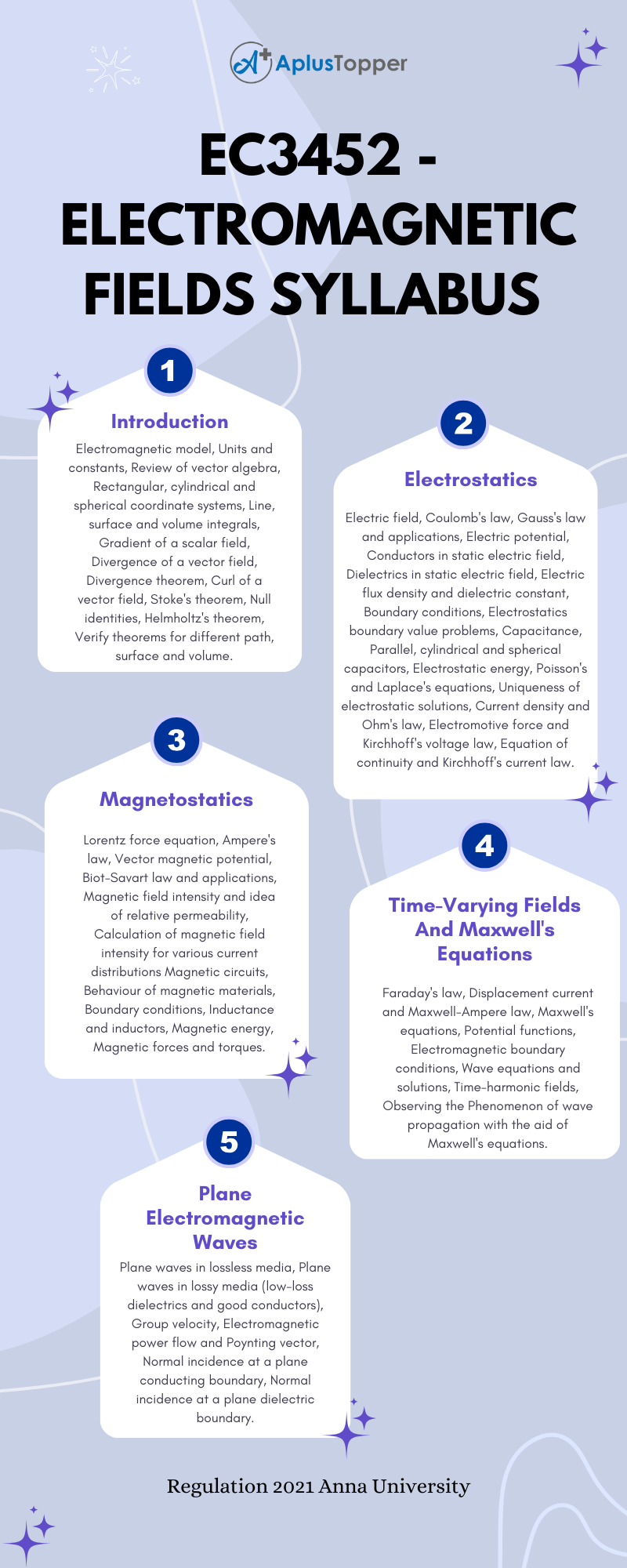Code EC3452 deals with the subject from the Anna University Regulation 2021, related to affiliated institutions, syllabus of B.E Electronics and Telecommunication Engineering. In this article, we discuss the Electromagnetic Fields Syllabus.
We intend to provide the syllabus of EC3452 – Electromagnetic Fields, we include the textbooks and references from the faculty of experts. You can get the required information unit-wise. The following links will help you to get proper information. I hope you can find the details in the article given below.
If you want to know more about the syllabus of B.E Computer Science and Engineering (Cyber security) Syllabus connected to an affiliated institution’s four-year undergraduate degree program. We provide you with a detailed Year-wise, semester-wise, and Subject-wise syllabus in the following link B.E Electronics and Telecommunication Engineering Syllabus Anna University, Regulation 2021.
Aim of Objectives:
- To impart knowledge on the basics of static electric field and the associated laws.
- To impart knowledge on the basics of static magnetic field and the associated laws.
- To give insight into coupling between electric and magnetic fields through Faraday’s law, displacement current and Maxwell’s equations.
- To gain the behaviour of the propagation of EM waves.
- To study the significance of Time varying fields.
EC3452 – Electromagnetic Fields Syllabus
Unit – I: Introduction
Electromagnetic model, Units and constants, Review of vector algebra, Rectangular, cylindrical and spherical coordinate systems, Line, surface and volume integrals, Gradient of a scalar field, Divergence of a vector field, Divergence theorem, Curl of a vector field, Stoke’s theorem, Null identities, Helmholtz’s theorem, Verify theorems for different path, surface and volume.
Unit – II: Electrostatics
Electric field, Coulomb’s law, Gauss’s law and applications, Electric potential, Conductors in static electric field, Dielectrics in static electric field, Electric flux density and dielectric constant, Boundary conditions, Electrostatics boundary value problems, Capacitance, Parallel, cylindrical and spherical capacitors, Electrostatic energy, Poisson’s and Laplace’s equations, Uniqueness of electrostatic solutions, Current density and Ohm’s law, Electromotive force and Kirchhoff’s voltage law, Equation of continuity and Kirchhoff’s current law.

Unit – III: Magnetostatics
Lorentz force equation, Ampere’s law, Vector magnetic potential, Biot-Savart law and applications, Magnetic field intensity and idea of relative permeability, Calculation of magnetic field intensity for various current distributions Magnetic circuits, Behaviour of magnetic materials, Boundary conditions, Inductance and inductors, Magnetic energy, Magnetic forces and torques.
Unit – IV: Time-Varying Fields And Maxwell’s Equations
Faraday’s law, Displacement current and Maxwell-Ampere law, Maxwell’s equations, Potential functions, Electromagnetic boundary conditions, Wave equations and solutions, Time-harmonic fields, Observing the Phenomenon of wave propagation with the aid of Maxwell’s equations.
Unit – V: Plane Electromagnetic Waves
Plane waves in lossless media, Plane waves in lossy media (low-loss dielectrics and good conductors), Group velocity, Electromagnetic power flow and Poynting vector, Normal incidence at a plane conducting boundary, Normal incidence at a plane dielectric boundary.
Text Books:
- D.K. Cheng, Field and wave electromagnetics, 2nd ed., Pearson (India), 2002.
- M.N.O.Sadiku and S.V. Kulkarni, Principles of electromagnetics, 6th ed., Oxford(Asian Edition), 2015.
References:
- Edward C. Jordan & Keith G. Balmain,Electromagnetic waves and Radiating Systems, Second Edition, Prentice-Hall Electrical Engineering Series, 2012.
- W.H. Hayt and J.A. Buck, Engineering electromagnetics, 7th ed., McGraw-Hill (India), 2006.
- B.M. Notaros, Electromagnetics, Pearson: New Jersey, 2011.
Related posts on Semester – IV:
Must Read:
